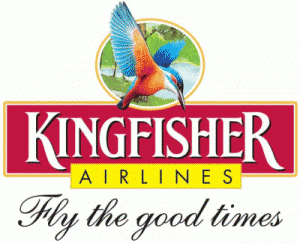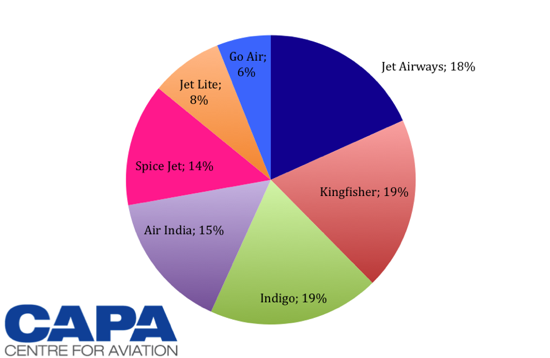 The Indian air market is estimated to be the ninth largest in the world but with the population size the country has, the Indian government believes it will become the world’s third largest market by 202o. 87 foreign and five Indian airlines fly to and from India to 40 countries. Approximately five million Indians fly every month domestically. Domestic traffic more than doubled between Jul-2006 and July 2011, with growth of 101%. One reason for the growth was the deregulation of Indian domestic aviation in 2003- 2004 followed by international deregulation in 2007-2008
The Indian air market is estimated to be the ninth largest in the world but with the population size the country has, the Indian government believes it will become the world’s third largest market by 202o. 87 foreign and five Indian airlines fly to and from India to 40 countries. Approximately five million Indians fly every month domestically. Domestic traffic more than doubled between Jul-2006 and July 2011, with growth of 101%. One reason for the growth was the deregulation of Indian domestic aviation in 2003- 2004 followed by international deregulation in 2007-2008
Today, India’s airlines have some of the youngest fleets in the world and new airport facilities have blossomed across the country. For example Delhi’s Indira Gandhi International Airport (IGIA) was awarded the fourth best airport award in the world. When I flew there prior to the rebuilding of the airport, it was an awful airport.
India has three full service airlines Air India, Jet Airways, Kingfisher Airlines and four Low cost carriers: GoAir, IndiGo, JetLite (owned by Jet airways), and SpiceJet. Kingfosher also had a discount version: Kingfisher Red known formerly as Simplifly Deccan and before that Air Deccan. I have only flown Jet, preferring to travel through India on their amazing railway system but that’s another story. Market share from September, 2011 is shown below.

The industry, however is not making money. Indian airlines will lose up to $3 billion in the fiscal year that ends this month, according to CAPA, with state-owned Air India accounting for the bulk of the losses. Three of those airlines are in severe financial trouble: Air India, Jet, and Kingfisher:
- Air India has received a series of government bailouts.
- Jet who were profitable for the first years of their expansion are looking for credit.
- Kingfisher has never made a profit in its six year history and after a period of massive expansion has grounded more than half of its planes as it struggles to pay staff and creditors and scrambles to find investors. It seems only a matter of when, not if, Kingfisher Airlines will go.
 Indians know the Kingfisher name as it is the country’s most popular beer accounting for a third of domestic beer consumption. Owned by United Breweries, the beer was launched in 1987 and enjoyed phenomenal growth. The logic that anything with the Kingfisher name can grow in the same way seems to have propelled an insane airline expansion. For example, in 2008 it was stated: UB group has become the market leader in each core business it has ventured into.
Indians know the Kingfisher name as it is the country’s most popular beer accounting for a third of domestic beer consumption. Owned by United Breweries, the beer was launched in 1987 and enjoyed phenomenal growth. The logic that anything with the Kingfisher name can grow in the same way seems to have propelled an insane airline expansion. For example, in 2008 it was stated: UB group has become the market leader in each core business it has ventured into.
Kingfisher Airlines began operations on 9 May 2005 with an inaugural flight from Mumbai to Delhi. A month later (June 15, 2005,) it ordered five A380s, five Airbus A350s aircraft and five Airbus A330s. It seems staggering that an airline a month old could order the world’s biggest plane in an untested market. They went international in 2008, less than four years ago. In May 2009, they became India’s largest airline by passenger numbers.
Kingfisher aimed to offer a premium service on all of its flights. Dr. Vijay Mallya, the Chairman of Kingfisher Airlines Limited said: I intend to make Kingfisher Airlines the best in the world and pursue this goal seriously… I have always aimed at delighting you and giving you nothing but the best.
It aimed to see customers as guests not passengers. As a result Kingfisher could boast it was one of the only seven airlines awarded the coveted 5-star rating by Skytrax. This put it in the same category as Cathay Pacific, Qatar Airways, Asiana Airlines, Malaysia Airlines, Singapore Airlines, and Hainan Airlines. It gave every guest a free welcome on board kit including pen, facial tissue and headphone to use with their entertainment system. They had the greatest leg room with a 34 inch pitch (distance between seats) and won accolades for their best economy class seat. Kingfisher was the first of India;’s airlines to install an interactive entertainment system and made a deal with Dish TV to provide live TV entertainment to passengers. Passengers are served meals on most flights and bottled lemonade (not beer!) before take-off.
Kingfisher grew their fleet size to 68 aircraft with 90 on order ncluding those A380s mentioned previusly. The average age of its fleet was just 2.3 years. The carrier was flying to 63 domestic destinations and eight international destinations across Asia and Europe. It had code share agreements with American Airlines, British Airways and Philippines. They were also accepted into the One World Alliance.
Fast forward to the last year and Kingfisher have moved from flying high to the verge of bankruptcy. The crisis unfolded as:
- 31 Aug 2011 – Kingfisher delayed salaries for its staff and continued to delay salary payments. They have also failed to pay income tax payments diretly to tax authroties
- 15 Nov 2011 – Dr. Vijay Mallya, Chairman, vowed the airline will keep flying
- 8 Dec 2011 – Kingfisher Pilots start making this in-flight announcement: “It is their sense of duty towards the guest that is making them fly despite not being paid salaries for the past two months”
- 8 Dec 2011 – Kingfisher reports Tax authorities froze 60 of their bank accounts. This has hampered their ability to pay salaries and dues
- 19 Dec 2011 – Kingfisher grounds 15 planes as it was unable to meet the maintenance and overhaul expenses.
- 20 Jan 2012 – Plane manufacturer ATR cancelled Kingfisher Airlines’s order for 38 ATR-72 turboprop planes
- 23 Feb 2012 – Kingfisher flight cancellations began in earnest with 4o planes grounded
- 3 Mar 2012 – Kingfisher pilots threaten to stop flying unless salaries are paid by 12 Mar 2012
- 6 Mar 2012 – the International Air Transport Association (IATA) suspended Kingfisher from its Geneva-based clearing house (ICH) due to non-payment of dues
- 7 Mar 2012 – One world deferred entry into their alliance
- 7 Mar 2012 – State-owned Hindustan petroleum Corporation Limited (HPCL) stopped jet fuel supplies. Bharat Petroleum Corporation Limited continued to sell fuel to the airlines on a cash-and-carry basis at some airports. HPCL resumed some supplies to allow skeletal services the next day


It will be in the future for sure.